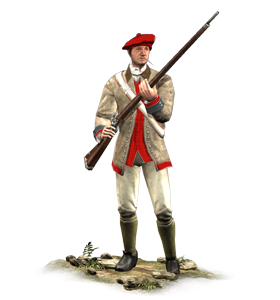Militia (ETW Unit)
![]() These musket-armed troops are recruited to defend their own locality, not carry the war to an enemy’s land.
These musket-armed troops are recruited to defend their own locality, not carry the war to an enemy’s land.
Contents
Overview
Militia or provincial troops are commonly held to be inferior to regular soldiers and, although they are trained to use the same tactics as marching regiments of the line, there is some truth in this assertion. Militia are expected to act as reassuring presence, and sometimes as a police force in suppressing local disturbances.
Historically, it was not unusual for militia to be locals recruited as part-time soldiers while retaining their day jobs and trades. In Britain, for example, service in the militia was seen as a good idea: you not only looked very patriotic for volunteering, but you could not be sent overseas! For ambitious would-be officers, there was a hidden financial benefit to joining the militia. A commander who could persuade his men to transfer to the army with him would not have to pay the cost of his regular commission.
Unit Details
Militia are cheap infantry available to most Western nations, with a few exceptions: Russia fields Cossack Infantry in their place, while the United States have Minutemen. The Eastern nations have assorted rabble that all qualify as militia equivalents.
Militia, and their equivalents, are useful in the early game as cheaper alternatives to line infantry (despite their inferior statistics). They become less effective, however, when more and more nations field regular line infantry in their armies. Militia also do not benefit from the Fire by Rank technology, effectively meaning they have only a third of the firepower of line infantry when this technology is researched; in addition, they cannot utilize the Square Formation, making them vulnerable to cavalry. However, militia remain useful in the late game for putting down rebellions and keeping the peace: although they do not receive bonuses to repression like dragoons, they are very cheap to field and have low upkeep costs, making them ideal for garrisons.
Like some other units such as artillery and light infantry, militia gain the option to pre-deploy some defensive measures on a battlefield should they remain in the place on the campaign map for more than two turns: defensive barriers behind which militia can shoot and crouch. This grants militia much more resistance against enemy musket fire, and somewhat slows and weakens charges. Militia also have access to anti-cavalry wooden barricades.
Factions
Factions
 Great Britain
Great Britain United Provinces
United Provinces Austria
Austria Bavaria
Bavaria Gran Colombia
Gran Colombia Courland
Courland Denmark
Denmark France
France Genoa
Genoa Georgia
Georgia Greece
Greece Hannover
Hannover Hessen
Hessen Hungary
Hungary Ireland
Ireland Louisiana
Louisiana Maratha Confederacy
Maratha Confederacy Mexico
Mexico Naples & Sicily
Naples & Sicily New Spain
New Spain Norway
Norway Italian States
Italian States Savoy
Savoy Poland-Lithuania
Poland-Lithuania Portugal
Portugal Prussia
Prussia Quebec
Quebec Russia
Russia Saxony
Saxony Scotland
Scotland Spain
Spain Sweden
Sweden Thirteen Colonies
Thirteen Colonies United States
United States Venice
Venice Westphalia
Westphalia Württemberg
Württemberg Knights of St John
Knights of St John
